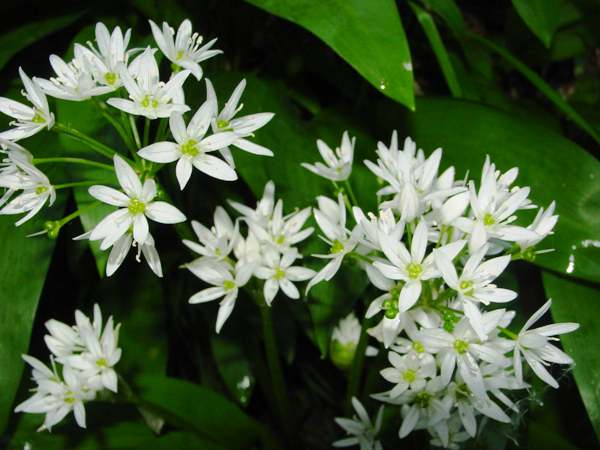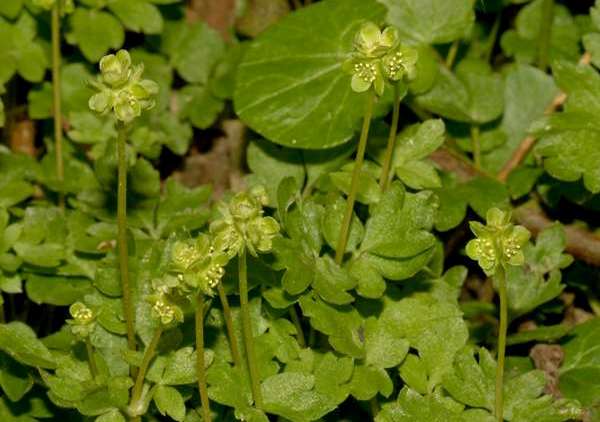
Coed Dolgarrog National Nature Reserve, Near Llanrwst, North Wales
Designations: SSSI
Below: Ramsons - Wild Garlic - is one of the plants that grow in Coed Dolgarrog

This nature reserve is a wooded area situated on the western side of the Conwy Valley. It contains two distinct types of woodland that include mature Beech trees seldom found in this part of Wales; they were almost certainly planted but add an important habitat to the site which is particularly good for fungi in the autumn. The other habitat type is wet Alder woodland, which is also rare in North Wales.
Directions
Grid Ref: SH771662
Coed Dolgarrog is situated off the B5106 road between Conwy and Betws y Coed.
Once in the village of Dolgarrog look for the Lord Newborough Public House, which is very close to the bridge over the Afon Porth Llwyd. Beside this bridge there is unofficial off-road parking for between 15 and 20 cars.
It is also possible to park on the side of the road in Dalgarrog itself not too far from the nature reserve.
Facilities
There are no facilities at the reserve, but there are shops and pubs in Dolgarrog, and public toilets can be found beside the Post Office. There are information boards at various locations inside the nature Reserve.
Access
From the bridge over the Afon Porth Llwyd at Dolgarreg there is a track leading into the nature reserve. Inside the woodland the paths, which have stiles and gates, are rocky and very steep in places and are not suitable for wheelchair users or for prams and pushchairs. Good walking shoes are essential.
Description of Site
Below: Town Hall Clock (Adoxa moschatellina) is an unusal plant in this part of North Wales

The underlying geology, being less acidic, is different in this steep valley site from most other parts of Wales. It is this that enables a combination of tree, fungi, plant and insect species not found in other parts of North Wales to survive here at Coed Dolgarreg.
The broadleaved woodland lies on steep, rocky terrain on the sides the valley, and the wet Alder woodland (known as Plateau Alderwood) runs along the upper part of the reserve on the banks of the Afon Ddu.
In the broadleaved woodland there are large stands of Beech trees (Fagus sylvatica) which are naturalised, but the other trees include Ash, Sycamore, Small-leaved Lime and Wych Elm. Wych Elm is not as susceptible to Dutch Elm Disease which has destroyed most of the UK's populations of English Elms (Ulmus procera) - although even Wych Elm eventually succumbs to this fungal infection and so due to the lack of mature specimens it has only a small presence in the wood nowadays.
The base-rich nature of the woods at Coed Dolgarrog means that the woodland flowers there are more diverse than in most of the acid-based oak woodlands that cover so much of this part of North Wales. Dog's Mercury (Mercurialis perennis), Enchanters Nightshade and the pungent Ramsons or Wild Garlic (Allium ursinum) are common, but there is also a chance of finding Early Purple Orchids (Orchis mascula) in the early spring, and later in the year, Broad-leaved Helleborines (Epipactis helleborine). Less common species include Town Hall Clock (Adoxa moschatellina), Woodruff and Wood Millet (Milium effusum). But, it is probably the carpets of Bluebells (Hyacinthoides non-scripta) that make Coed Dolgarrog such a lovely place to visit in springtime.
In the autumn it is a different story. Some interesting and rare fungi have been found in the woodland. Lime-loving species that occur here and that are most frequently associated with Beech trees include various Dapperlings (notably many Lepiota species including Lepiota cristata, the Stinking Dapperling) that were formally referred to as Parasols. The rarest of these recorded in Coed Dolgarrog is the Dew-drop Dapperling (Chamaemyces fraccidus)whose brown scaly stem exudes yellow droplets - hence its common name. Cysolepiota bucknalli is also known to occur in this are - it's strange combination of lilac colours and a strong smell of gas helps with identification.
Up on the cliffs that loom over the valley, Peregrine Falcons (Falco peregrinus) can be seen, but down in the woodland, more than 30 other bird species are known to breed. These include Wood Warblers, Redstarts and Pied Flycatchers. Other woodland birds making an appearance at Coed Dolgarrog are Bullfinches, Long-tailed Tits, Siskins and Lesser Redpolls. In winter large numbers of Fieldfares and Redwings are sometimes seen in the fields adjacent to the woodlands.
The habitats found in Coed Dolgarrog make it a great place to see insects, and one rare crane fly that appears here and is dependent on Beech trees, is the Yellow-ringed Comb Horn Crane Fly. Other rare insects that live in the woodland include various moths such as the Beautiful Brocade Moth, Blomer's Rivulet Moth, Pale Pinion Moth and Brindled Ochre Moth.
For those with a general interest in wildlife Coed Dolgarrog is not a bad place to spend the day!